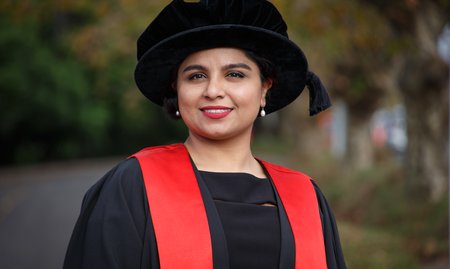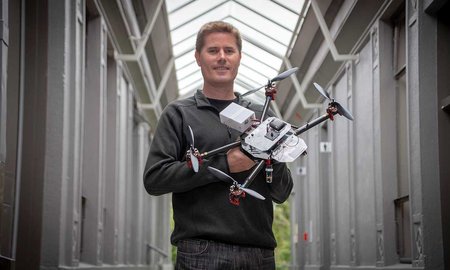
Dr Chris Muller.
The yellow-eyed penguin, also known as the hoiho, are found only in Aotearoa New Zealand waters. With a declining population and without intervention, they are predicted to go extinct on the mainland within a few decades. Until recently, little was known about the subantarctic population as their isolated location made it difficult to carry out research for conservation purposes.
Dr Muller used his doctoral studies to investigate the population ecology and foraging behaviour of yellow-eyed penguins on the subantarctic Auckland Islands. He says his research helped shed a light on significant parts of their lifestyle.
“My findings included the first estimate of breeding numbers on the Auckland Islands in 30 years, as well as discovering new information relating to the southern population’s diving behaviour, foraging location and diet. It was interesting to learn that foraging behaviour in this population differed from that on the mainland. The Department of Conservation has used this information to inform management decisions on their conservation and to update the International Union for Conservation of Nature (IUCN) Red List of Threatened Species database.”
To conduct his research, Dr Muller spent three summers living on an isolated, subantarctic island. He says his interest in the Southern Ocean and finding ways to preserve it meant that when this thesis came up, he knew he had to go for it despite the unconventional fieldwork involved.
“I had previously worked for several seasons in the subantarctic, so I knew what I was getting myself in for and it was a once-in-a-lifetime opportunity, so I quit my job and dove straight in. It took two days on a sailing yacht in the Southern Ocean through the ‘Furious Fifties’ to get there and back.”
Dr Muller says while the conditions weren’t glamorous, he learnt to adapt.
“I lived in a field hut for three and a half months at a time with no power, phone or internet, including over the Christmas and New Year holidays, with only a solar panel and a satellite phone for emergencies. I had to take everything I needed since I couldn’t replace lost or broken equipment, so I got good at fixing everything from clothes to electronics.”
“Penguin counting started each day before first light at 4am and catching finished at last light around 11pm. In between, I would locate and monitor nests in rough terrain and inclement weather. I caught and microchipped hundreds of penguins which allowed for monitoring of their foraging and breeding activities.”
During his PhD, Dr Muller developed a drone-based technology to help revolutionise wildlife tracking and monitoring efficiency in difficult terrain. Following the completion of his research, Dr Muller says he’s started a company to commercialise the technology.
“The new drone tracking equipment offers significant savings for locating a wide range of animals. With advice and assistance from Callaghan Innovation, Massey eCentre, The Factory and the Central Economic Development Agency, Altitude Conservation has been established. The equipment has since been upgraded for use on other platforms including piloted aircraft and vehicles, and we’re working with researchers around the world to conserve endangered species.”
The technology has already been used to assist with a number of conservation projects, including a Massey research project monitoring Toutouwai North Island robins translocated to Turitea forest. It’s also a finalist in the 2023 NZ Hi-Tech Awards in the Innovative Hardware category.
Dr Muller completed a Bachelor of Science and a Master of Science at the University of Auckland, which included papers on antarctic ecosystems. He went on to spend time in the South Island, completing a Graduate Certificate in Antarctic Studies at the University of Canterbury, which furthered his interest in Antarctica and the Southern Ocean.
After completing his master’s, Dr Muller took a break to get some work experience which he says set him up well for when he returned to start his PhD.
“I had some tricky method problems to overcome but my industry experience and networking contacts were a big help with that.”
Dr Muller completed his PhD at the Manawatū campus and lives with his wife and son in Palmerston North, who he says he’s incredibly grateful to.
“My son was born the day before my PhD defence was due which threw a bit of a spanner in the works, but luckily I was able to reschedule. He’s a great study buddy and would sit on my lap while I worked. I’d like to say a huge thanks to my wife, who is also my research partner, and to my family for their unwavering support. I’m also thankful to my supervisors Professor Louise Chilvers and Associate Professor Phil Battley for their understanding and assistance throughout my PhD, and for the several scholarships I received in support of my research, including a Massey PhD scholarship.”
Related news
Uncovering the secret life of blackbirds
Dr Mehrnaz Tavasoli dedicated her PhD study to broadening the understanding of how individuality in behavioural traits contributes to reproductive success and survival in common blackbirds.

Saving endangered bird species a passion for PhD graduate
For his doctoral research, Dr Enzo Reyes investigated the factors that need to be considered to successfully translocate the endangered Floreana mockingbird to Floreana Island in the Galápagos Archipelago.

Massey PhD student wins Innovate 2018
Massey PhD student Chris Muller has won the Innovate 2018 competition for drone-based technology that has the potential to revolutionise the monitoring of animals.
